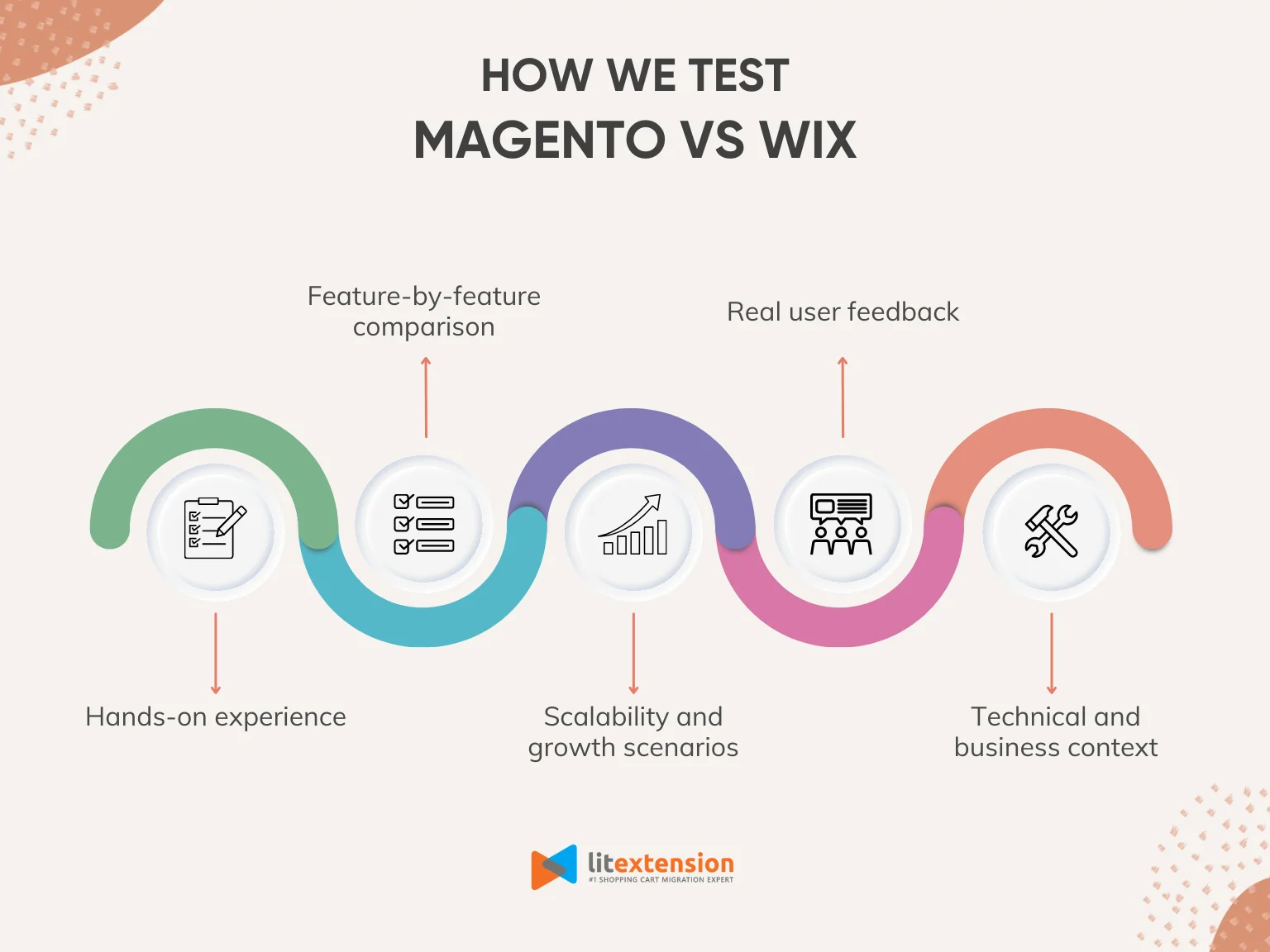If you are considering different approaches to build an online store, Magento vs Wix are definitely two well-known names worth consideration.
Though both platforms offer powerful features to help you grow, there are several differences you should know before choosing one. Magento gives you full control and advanced features, but it also requires more technical knowledge and higher maintenance. On the other hand, Wix offers an easy setup and user-friendly tools, but its capabilities may be limited as your business scales.
In this article, we will walk you through the key differences between Magento vs Wix to help you make an informed decision. Keep reading for a full comparison of:
- Ease of use
- Customizability & flexibility
- eCommerce features
- Performance & scalability
- SEO & marketing tools
- Apps & integrations
- Security compliance
- Support
- Pricing
Without further delay, let's get right into it!
Magento vs Wix – Key Takeaways
We must say that Magento and Wix serve very different audiences, and the right choice depends on your business goals, technical skills, and growth plans.
If you're looking for powerful customization, enterprise-level features, and long-term scalability, Magento stands out, but with a steeper learning curve and higher setup costs. Wix, in contrast, is easy to use, affordable, and perfect for small to mid-sized stores that need a fast launch with minimal technical effort. While it doesn’t offer as much backend control as Magento, it simplifies the process for users who want to focus on running their business, not building infrastructure.
Let's take a side-by-side look at how both platforms perform across key areas:
Criteria | Magento | Wix | The Winner |
Ease of use | Requires intermidate technical expertise | Beginner-friendly with drag-and-drop editor | Wix |
Customization & Flexibility | Fully customizable (open-source) | Limited backend flexibility | Magento |
Inventory Management | Strong, suitable for complex needs | Basic to moderate tools | Magento |
Payment Gateways | Wide range of integrations | Fewer options, but simple to set up | Magento |
B2B Selling Tools | Built-in support for B2B features | Lacks advanced B2B capabilities | Magento |
Reports & Analytics | Advanced reporting with extensions | Built-in, easy-to-read dashboards | A Tie |
Performance & Scalability | Highly scalable with proper setup | Limited for very large operations | Magento |
SEO & Marketing Tools | Full control, strong SEO features | Good built-in tools, easy setup | Magento |
Apps & Integrations | Large marketplace, dev-friendly | Curated app market, less flexible | Magento |
Security Compliance | User-controlled, customizable | Built-in, fully managed by Wix | Wix |
Support | Community forum and help docs | Help docs, learning hub, phone support | Wix |
Pricing | Flexible but can get expensive | Transparent cost with affordable plans | Wix |
In short, from our experience, Magento would be an ideal option if you:
- Run a growing or enterprise-level business with complex requirements.
- Need advanced product management and custom workflows.
- Have access to a development team or agency.
- Want full control over hosting, performance, and code.
On the other hand, consider using Wix if:
- You’re a beginner or solo entrepreneur launching a store quickly.
- You prefer a hosted, all-in-one platform with little technical setup.
- Your catalog is small to medium-sized, and you don’t need B2B features.
- You want to minimize costs and manage your site without a developer.
And that's basically everything you need to know about these two platforms. In the latter parts of our Magento vs Wix comparison, let's break down each solution to see what they have to offer.
Magento vs Wix – What You Need to Know
Before diving into detailed comparisons of Magento vs Wix this section will give you a quick overview of both platforms. Below, we'll walk you through the pros and cons of Magento and Wix to give you a clear picture of their strengths and limitations.
Magento pros and cons
Magento, or now Adobe Commerce, is a robust, open-source platform designed for businesses that need full control over their store’s backend, appearance, and performance. It’s especially well-suited for medium to large businesses with complex product catalogs, B2B operations, or custom checkout flows.
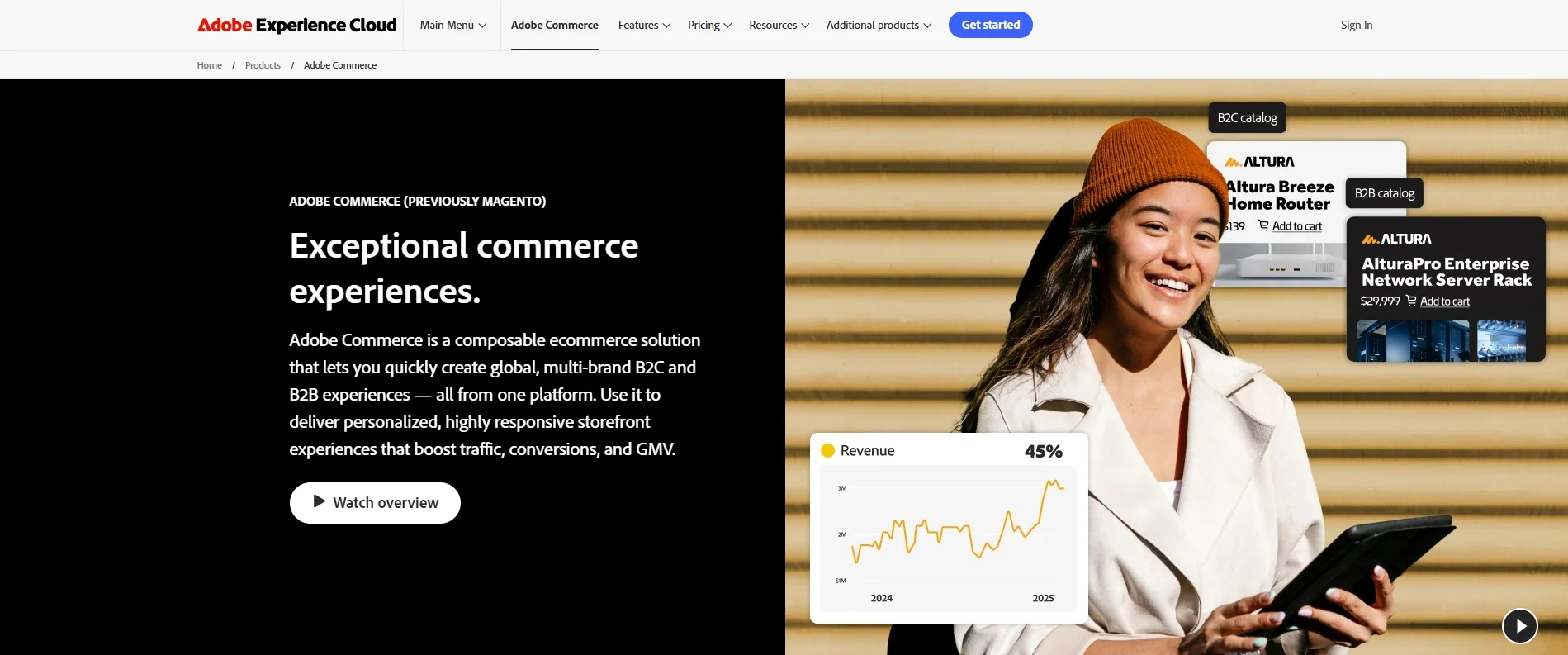
With Magento, you're not just using a website builder; you’re building a highly customizable eCommerce system from the ground up. However, this power comes with a trade-off: it requires technical expertise or a development team to handle installation, hosting, security, and ongoing maintenance.
Here are the pros and cons of Magento for your consideration:
Pros | Cons |
- Full control over your store thanks to open-source architecture. - Highly scalable, suitable for large inventories and high-traffic stores. - Advanced customization options for checkout, design, and backend logic. - Strong support for B2B selling, including customer groups, tier pricing, and quote management. | - Requires technical knowledge or developer support to set up and manage. - Longer development time compared to hosted platforms. - Higher costs for hosting, development, and maintenance. - More complex updates and module compatibility issues. |
For in-depth insights into Magento (or Adobe Commerce), please check out our full Magento review here or watch the video below.
Wix pros and cons
On the other hand, Wix is a fully hosted website builder with integrated eCommerce features. It’s aimed at small to mid-sized businesses, solopreneurs, or anyone looking to launch a store quickly without hiring developers.
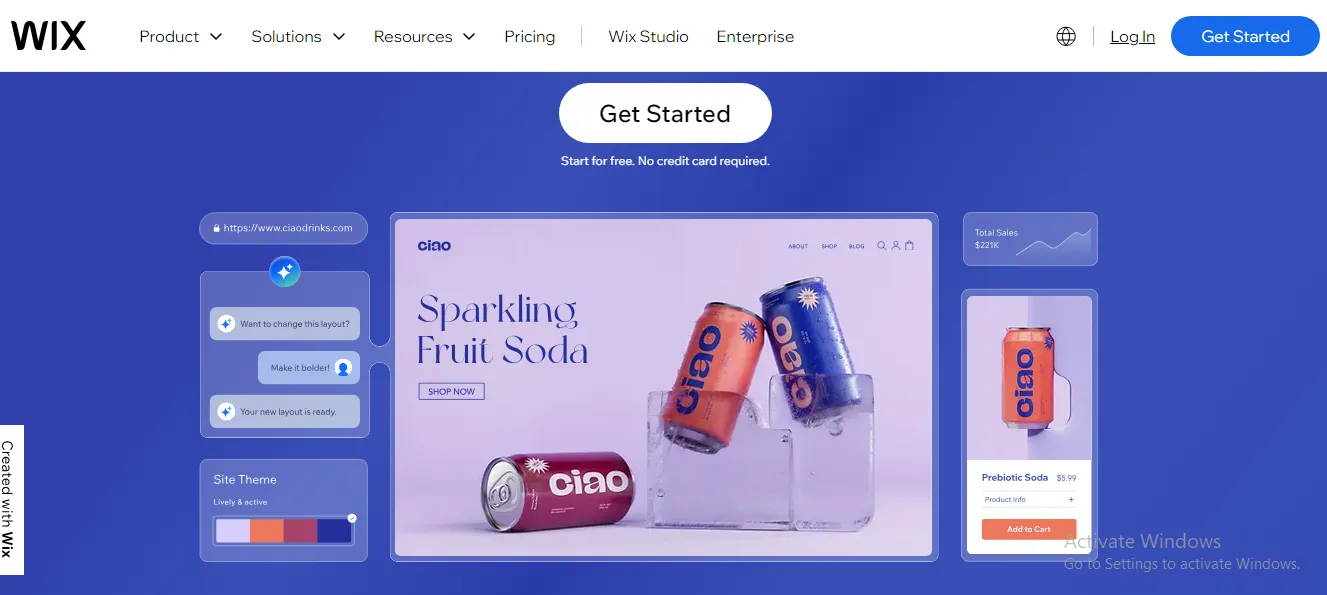
Wix provides an intuitive drag-and-drop editor, built-in templates, and a variety of business tools, all bundled under one roof. It simplifies everything from design to payments, making it an excellent choice for those who want ease of use without diving into technical details.
Here are the pros and cons of Wix for your consideration:
Pros | Cons |
- Beginner-friendly interface, perfect for non-technical users. - Fast setup process with pre-built templates and guided onboarding. - All-in-one platform, including hosting, SSL, and security. - Affordable pricing with clearly defined plans. - App Market for basic add-ons, such as reviews, forms, and live chat. | - Limited backend control, especially for advanced features. - Not ideal for large stores with thousands of products or custom logic. - Less flexible when it comes to third-party integrations or scaling. - Fewer B2B tools, making it less suitable for wholesale or custom pricing. |
And, if you want to learn more about this platform, please don't forget to read our Wix reviews or see the video below for more expert tips and insights.
Ease of Use
The verdict:
Wix clearly takes the lead in ease of use between Magento vs Wix. It’s designed for beginners with no coding skills, offering a simple drag-and-drop editor, built-in tools, and a fully guided setup process. Therefore, it'll be an ideal option if you want to launch your store quickly and manage everything without touching code.
When it comes to managing an online store, ease of use can make or break your experience, especially if you’re just getting started. In this section, we’ll break down how Magento vs Wix perform in terms of setup, day-to-day management, and user experience.
Magento is a powerful and flexible platform, but it is not beginner-friendly. To use Magento, you need to install the software manually, choose a hosting provider, and configure the system yourself. This setup process often involves working with command lines or technical documentation. In addition, the admin panel in Magento is packed with features that give you full control over your store’s operations, like managing products, customers, promotions, and other advanced settings.
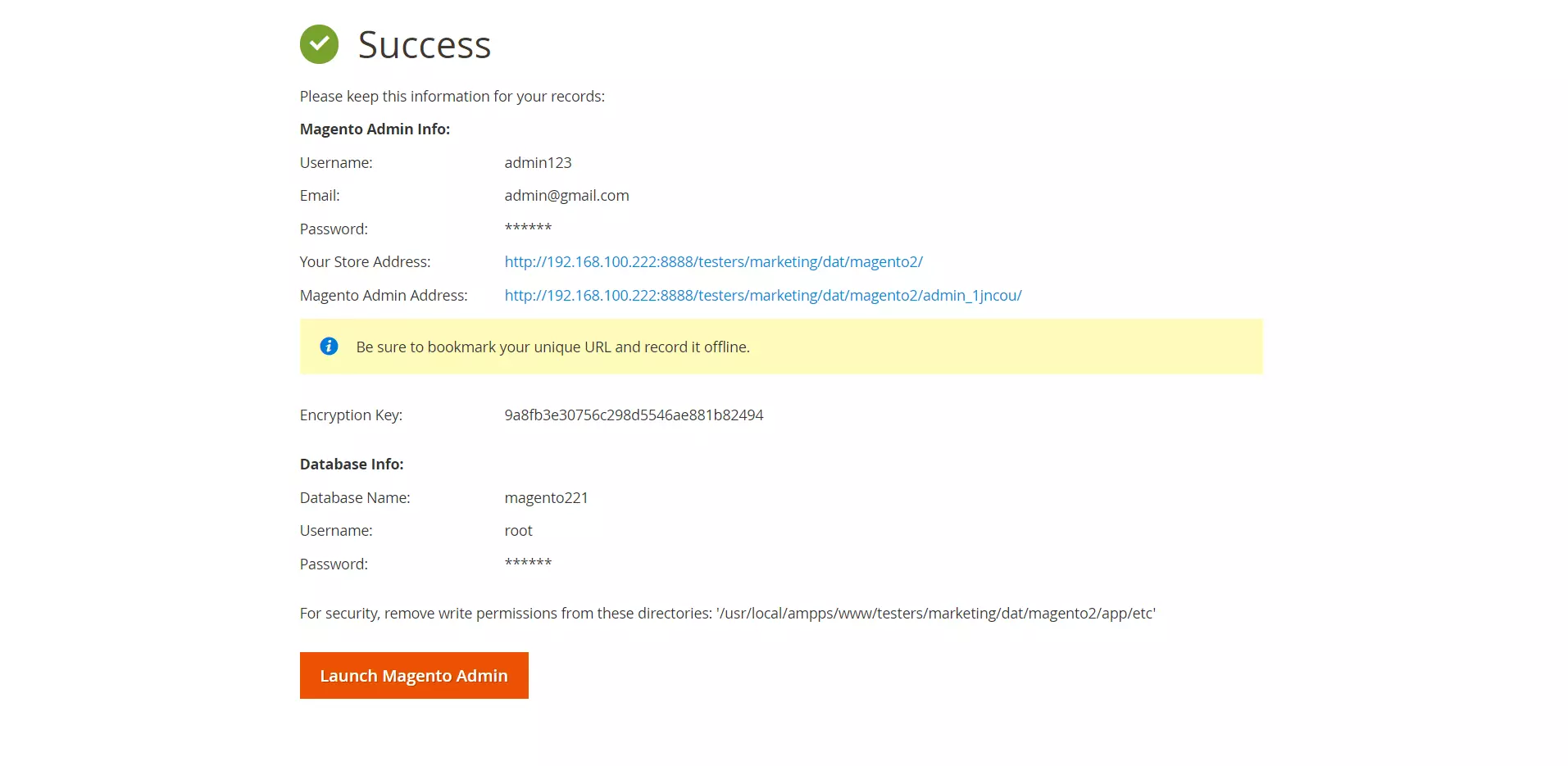
However, this level of control also makes the interface more complex, especially for those who are unfamiliar with eCommerce systems. Even routine tasks such as updating third-party extensions, optimizing performance, or applying security patches can be time-consuming and technical. Without the right support or experience, managing Magento on your own can quickly become a challenge.
However, unlike Magento, Wix takes a very different approach. It is a fully hosted solution, which means you don’t have to worry about technical tasks like choosing a server, setting up a database, or installing software. Everything is handled automatically by Wix in the background, allowing you to focus entirely on building and growing your online store rather than dealing with the technical foundation.
In addition, the Wix dashboard is modern, clean, and easy to navigate. Managing your inventory, processing orders, setting up shipping, and applying discounts can all be done through simple, guided workflows. You’ll also find helpful tips and step-by-step checklists throughout the dashboard to guide you through tasks as you go.
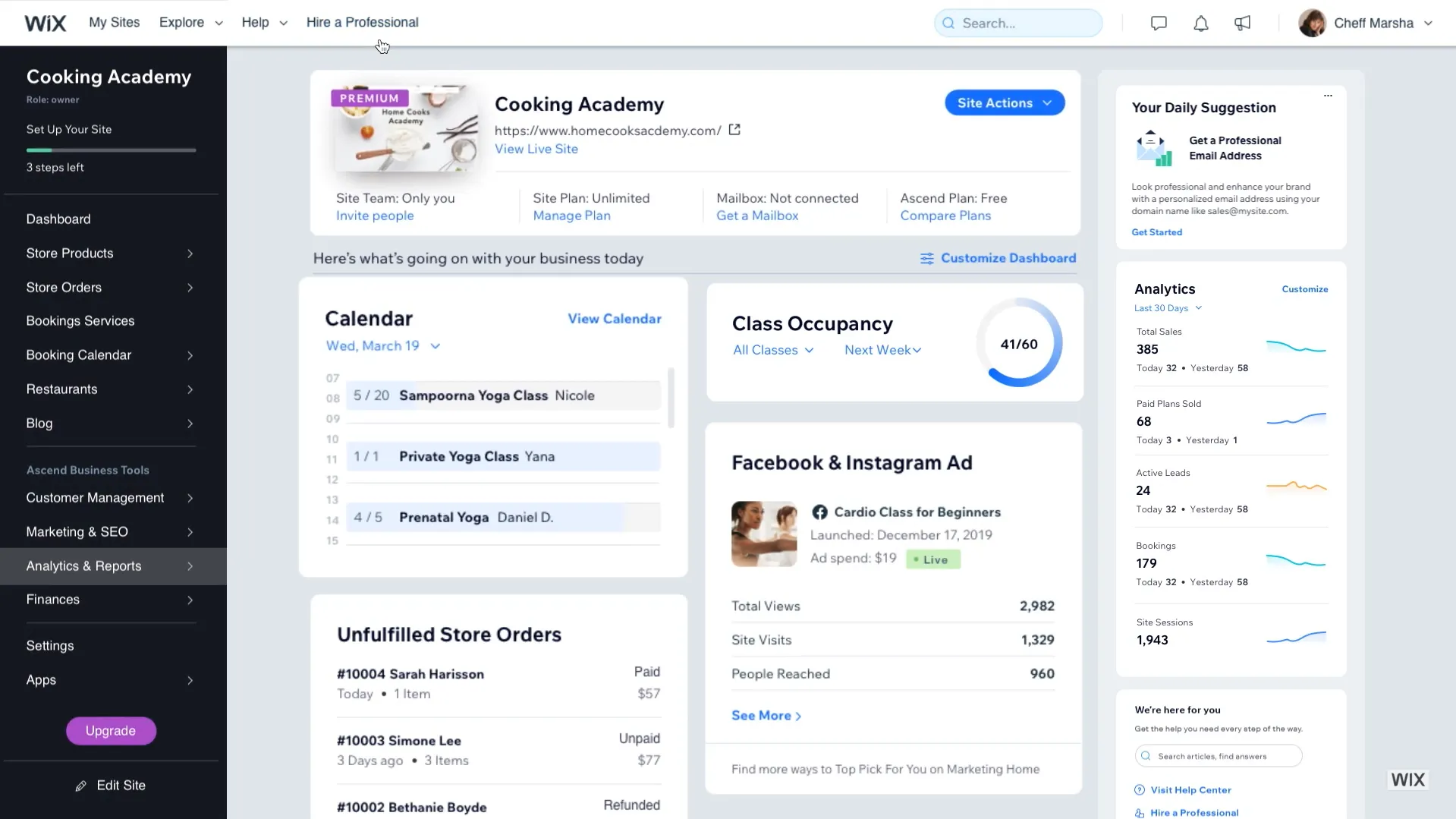
For business owners who want to launch quickly and run a store without technical support, Wix offers a stress-free, all-in-one solution. It’s ideal for users who value convenience and want to maintain control over their store without having to rely on developers or IT specialists.
Customization and Flexibility
The verdict:
Magento is the clear winner in terms of customization and flexibility between Magento vs Wix. As an open-source platform, it gives you full access to the codebase, allowing you to tailor every part of your store, from the front end to the backend logic. Therefore, if your store needs unique workflows or complex features, Magento is the better fit.
Every online store has unique needs, whether it's a custom checkout flow, a product configurator, or a personalized design. That’s why customization and flexibility are critical when choosing the right eCommerce platform. In this section, we’ll explore how Magento and Wix compare in their ability to adapt to your business requirements, support unique features, and scale with your growth.
Magento was designed with developers and large-scale businesses in mind. As an open-source platform, it allows you to modify the source code to build custom features that match your exact needs. You can customize everything, from your store’s design and layout to the way products are displayed, how discounts are applied, and how customers interact with your checkout.
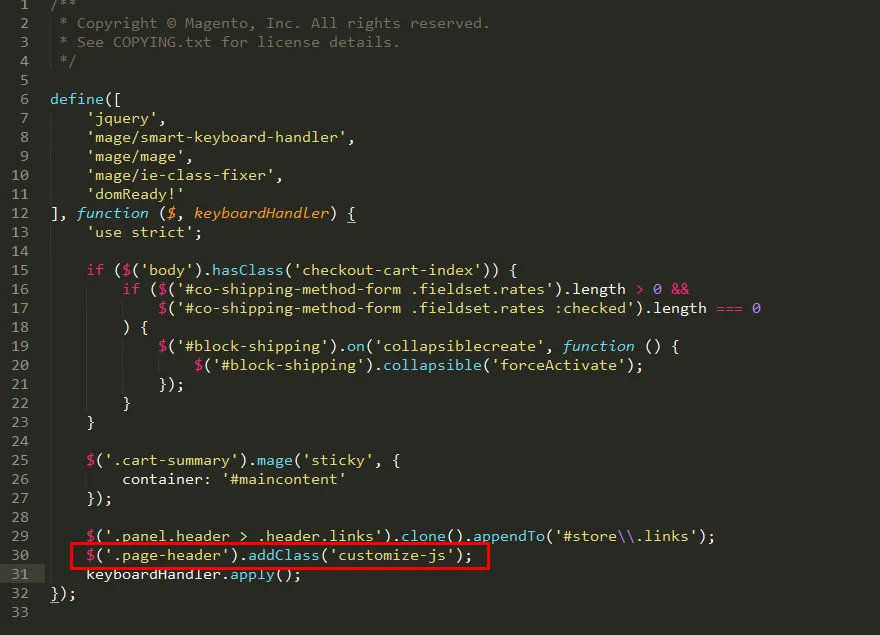
Additionally, Magento supports a modular architecture, which means you can install, upgrade, or remove extensions without affecting your core system. You can also build entirely new modules tailored to your business logic. Whether it’s integrating with custom ERP systems, adding advanced search filters, or creating dynamic pricing rules, Magento gives you the freedom to implement it all.
However, this power comes with complexity. Customization usually requires experienced developers who understand Magento’s architecture; otherwise, you might risk losing time and even money. But for businesses that need full control, Magento delivers unmatched flexibility.
In contrast, Wix offers a user-friendly way to build and customize your online store through its visual editor. You can select a pre-built Wix template, change fonts, colors, layouts, and images by simply clicking and dragging. This design freedom makes Wix appealing for beginners and small businesses that want a custom look without writing code.
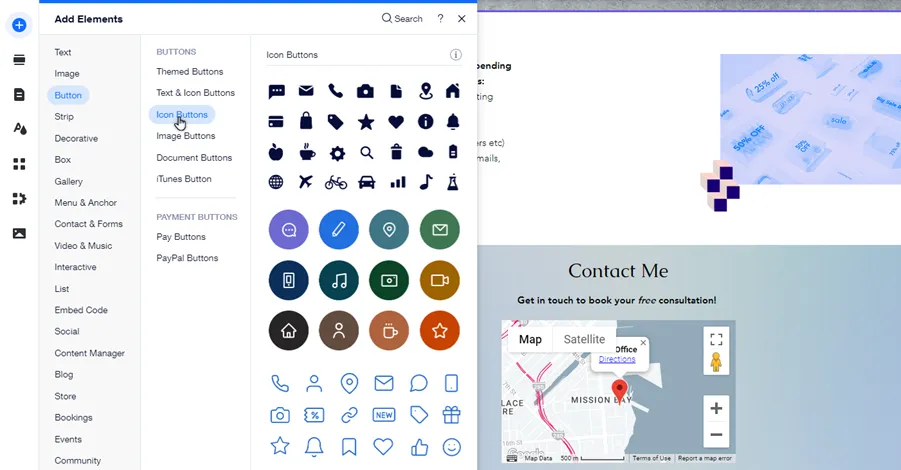
For added flexibility, Wix includes a feature called Velo by Wix, a development platform that lets you add custom code, APIs, and advanced functionality. While this extends Wix’s capabilities, it still doesn’t match Magento’s deep backend control or scalability.
In general, Wix is great for visual customizations and straightforward setups. But if your store requires complex logic, custom data flows, or integrations beyond what Wix’s App Market offers, you may find its customization tools too limited.
eCommerce Features
The core of any online store lies in its eCommerce functionality. From managing products to processing payments and tracking performance, these features directly impact how smoothly your business runs.
In this section, we’ll break down the essential tools you can expect from each platform and compare how Magento vs Wix handle key areas like inventory management, payment gateways, B2B selling, and analytics. Understanding these differences will help you decide which platform supports your store’s daily operations more effectively.
Inventory management
The verdict:
When it comes to inventory management between Magento vs Wix, Magento takes the lead. It offers more advanced tools, deeper customization, and better support for complex product structures. If you run a store with a large catalog, multiple warehouses, or need precise control over stock behavior, this solution is the better choice.
Inventory is one of the most important parts of running an online store. Whether you're managing hundreds or thousands of products, you need a system that helps you track stock, prevent overselling, and keep operations smooth. In this section, we’ll explore how Magento vs Wix compare when it comes to inventory management.
Magento offers a powerful and highly flexible inventory system. It allows you to manage stock across multiple sources and warehouses, making it ideal for businesses with complex logistics. You can create different product types, such as simple, configurable, bundled, or downloadable products, all with their own stock rules.
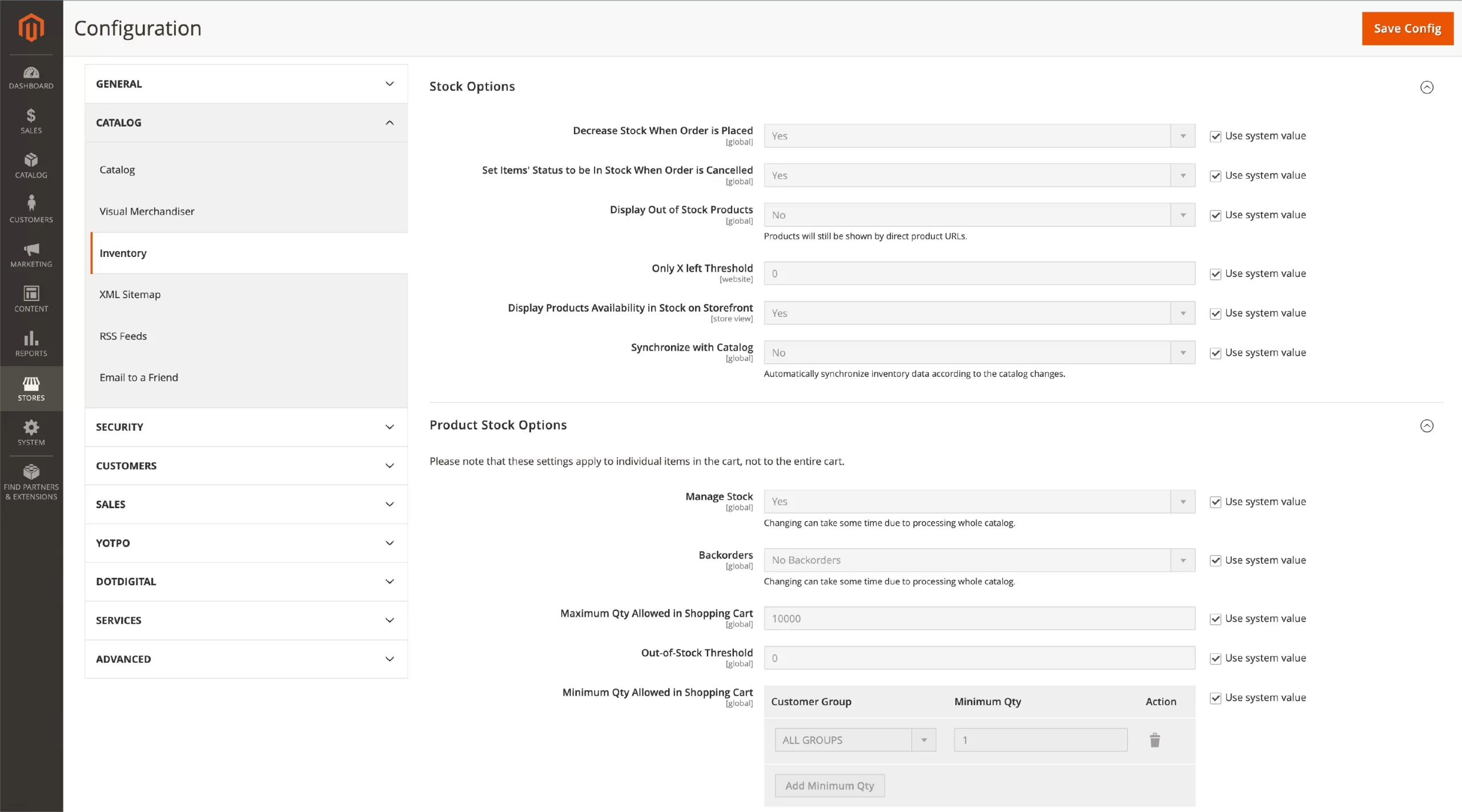
The platform also supports advanced features like low-stock alerts, partial shipments, backorders, and custom stock statuses. You can even set different stock settings for each store view if you’re managing multiple storefronts. These capabilities make Magento a strong option for large stores that need detailed inventory control and custom workflows.
On the flipside, Wix offers a built-in inventory management system that is simple and easy to use. It allows you to track product quantities, add product variants like color or size, and receive notifications when stock runs low. This platform also supports syncing inventory with its point-of-sale (POS) system, so you can manage both your online and in-store sales from one dashboard.
For business owners who want to get started quickly and keep things simple, Wix provides everything you need to stay on top of your inventory.

However, compared to Magento, Wix lacks support for more complex inventory setups. You won’t find native tools for multiple warehouses or advanced backorder logic. For that reason, between Magento vs Wix in inventory capabilities, Wix is better for simplicity, while Magento is better for scale and customization.
Payment gateways
The verdict:
Magento offers more flexibility and a wider range of payment gateway options, making it ideal for businesses that operate globally or need to support multiple payment methods. You can integrate almost any gateway, either through built-in settings, extensions, or custom development.
Payment gateways are a crucial part of any eCommerce store. They allow you to accept payments securely and efficiently, giving customers a smooth checkout experience. When comparing Magento vs Wix, it's important to look at how each platform handles payment integration, available options, and flexibility for businesses of different sizes.
Magento supports a wide range of payment gateways right out of the box, including PayPal, Braintree, Authorize.net, and others. Additionally, it offers full flexibility to integrate local or industry-specific gateways through extensions or custom code. This is especially useful for international businesses that need to support region-specific payment methods.
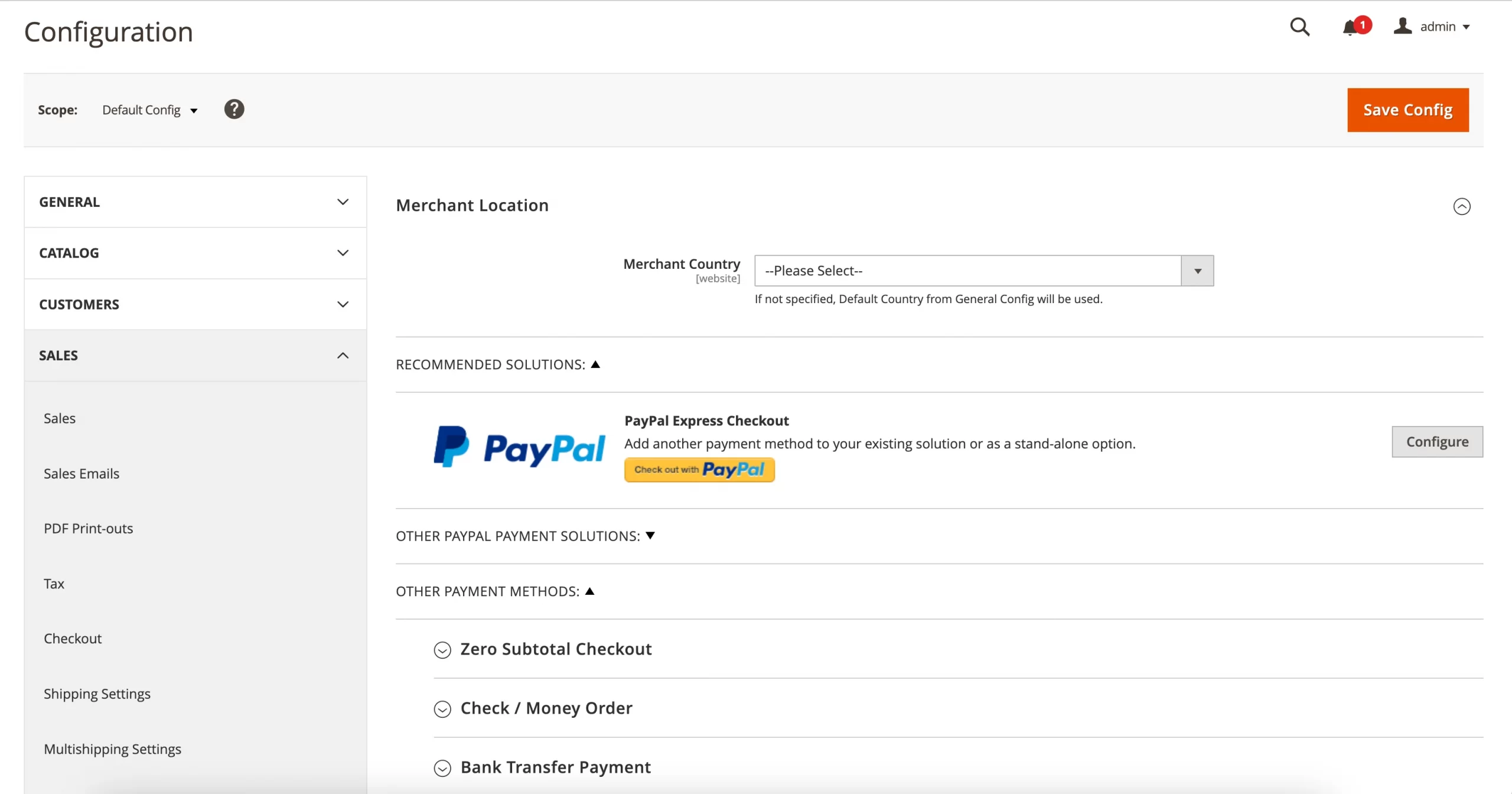
One of Magento’s strengths is the ability to control the checkout experience fully. You can configure rules, offer multiple payment methods on the same page, or create custom workflows based on customer groups or cart value. With access to the backend, developers can fine-tune every step of the payment process to match your business logic.
On the contrary, Wix makes it simple to start accepting payments. It comes with Wix Payments, the platform’s own payment gateway, which supports credit and debit cards, as well as services like Apple Pay. If you prefer a third-party option, Wix also integrates with PayPal, Stripe, Square, and a few other providers.

Setting up a payment method on Wix is fast and requires no technical skills. The platform guides you through the process, and all major settings are managed within a clean, user-friendly dashboard. This is perfect for store owners who want to start selling right away without getting into a complex configuration.
However, Wix doesn’t offer the same level of flexibility as Magento. If your business needs to work with less common payment providers or apply advanced logic at checkout, Wix may fall short. Additionally, some third-party gateways may not be available in all regions, limiting your choices depending on where you operate.
B2B selling tools
The verdict:
Magento is the clear winner when it comes to B2B selling tools between Magento vs Wix. It was built to handle complex selling scenarios, including bulk pricing, custom catalogs, and quote requests. If B2B is a key part of your business, Magento is the stronger platform.
With Magento, you can create customer groups and assign special pricing or discounts to each group. This allows you to show different catalogs or product prices to different businesses. You can also enable quote requests, allowing buyers to negotiate prices before placing orders, an essential feature in B2B transactions.
Magento supports purchase orders, credit limits, tiered pricing, and company accounts, where multiple users from the same business can place and manage orders under one organization. You can also manage tax-exempt statuses, configure custom shipping rules, and build advanced workflows tailored to each client.
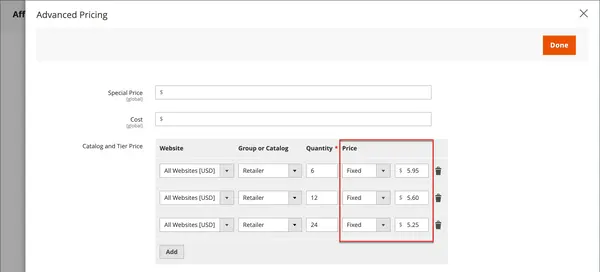
In short, Magento gives you full control over how you sell to businesses. It's well-suited for wholesalers, manufacturers, and distributors who need a powerful, flexible platform.
Whereas, while Wix is primarily focused on B2C, it does offer some entry-level tools for simple B2B selling. Using Wix's Wholesale Store template and member login feature, you can create a gated storefront that only registered buyers can access. You can also create discounted product pricing using coupon codes or automate pricing through member-based rules.
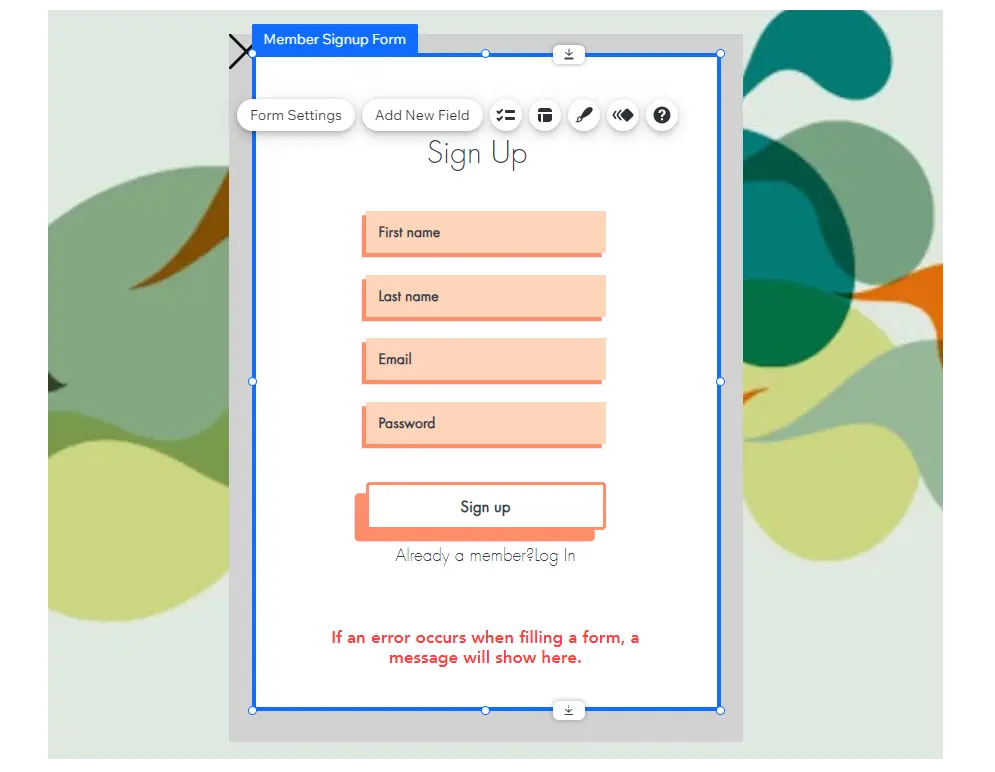
Some third-party apps in the Wix App Market allow you to manage bulk discounts, hide prices from guest users, or require approval for new accounts. However, these tools are limited in comparison to what Magento offers, and many advanced B2B needs, such as tiered pricing, quoting systems, or complex company account structures, are not supported natively.
Reports and analytics
The verdict:
Magento clearly stands out in terms of flexibility between Magento vs Wix. It allows you to create custom reports, integrate with advanced analytics tools, and tailor your dashboards to match your specific business needs.
In this section, we’ll explore how Magento vs Wix compare when it comes to built-in reporting tools, customization, and integration with external analytics platforms.
Magento provides a wide range of reports that cover sales, customers, products, taxes, and more. You can filter and segment your data to dig into specific time periods, customer groups, or product performance. This platform also allows integration with advanced analytics platforms, such as Google Analytics, GA4, or Adobe Commerce Business Intelligence, to give you deeper insights into customer behavior, conversion rates, and traffic sources. You can even create custom dashboards and reports based on your business needs.
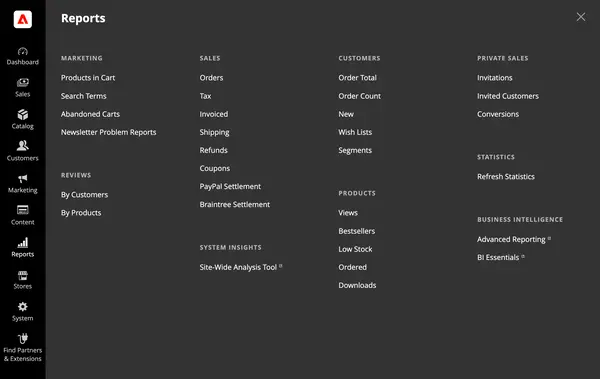
For even more flexibility, Magento supports third-party reporting extensions that let you build tailored reports, schedule exports, or connect to your BI tools. This makes Magento a strong choice for data-driven teams that rely on detailed insights to guide strategy.
Similarly, Wix includes a set of built-in analytics tools that are designed for ease of use. You can view sales performance, track your best-selling products, monitor visitor traffic, and measure marketing campaign results. The dashboards are clean and visual, making it easy for anyone, regardless of experience, to understand their store’s performance.
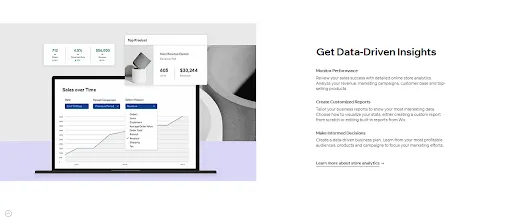
Wix also offers integrations with Google Analytics and Facebook Pixel, allowing you to track behavior across channels and set up remarketing campaigns. For many small to mid-sized businesses, these tools provide more than enough insight to make informed decisions.
However, Wix’s reporting features are more limited compared to Magento. There’s less flexibility in creating custom reports, and advanced features like multi-dimensional analysis or segmented reporting are not available out of the box.
Performance and Scalability
The verdict:
Between Magento vs Wix, Magento leads when it comes to scalability and long-term performance potential. It’s built for businesses that expect to grow and need a platform that can support high traffic volumes, large inventories, and advanced customizations.
In this section, we’ll compare Magento vs Wix in terms of their ability to handle growth and deliver consistent performance under pressure.
Magento is designed with high-performance and large-scale growth in mind. When properly configured and hosted, it can handle thousands of products and support heavy traffic during peak seasons like Black Friday or holiday sales. You can also use advanced caching, CDN integration, and performance optimization tools to improve site speed and reduce server load.
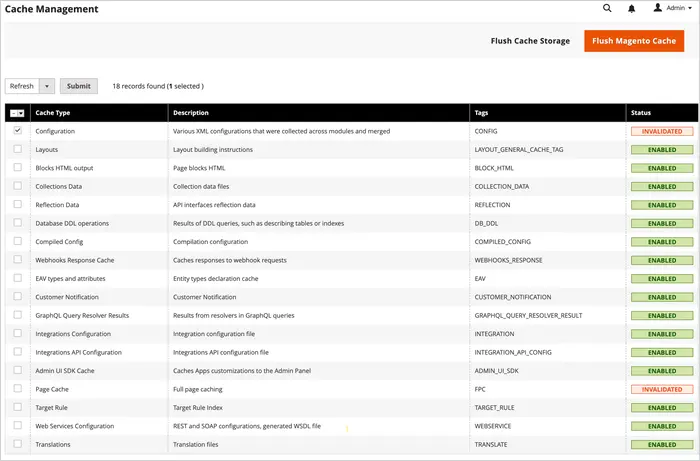
What makes Magento especially scalable is its modular architecture. You can add features, extensions, or even develop entirely custom modules without affecting your store’s core performance. This flexibility is critical for businesses that grow fast and need to adapt their store structure, product logic, or integrations along the way.
On the flip side, Wix offers pretty good performance right out of the box. Wix also uses a global content delivery network (CDN) to ensure fast loading speeds for visitors around the world. Page load times are fast for stores with moderate traffic and product catalogs, making it a great solution for small business owners who don’t want to worry about speed or server setup.
However, Wix has scalability limits. As your store grows larger, especially with high traffic, thousands of SKUs, or complex backend operations, you may start to hit the platform’s structural constraints. You can’t control hosting or server resources, and some performance-related features aren’t customizable.
SEO and Marketing Tools
The verdict:
When comparing Magento vs Wix in SEO and marketing tools, Magento surely offers more flexibility. It allows full access to technical settings, custom integrations, and detailed promotional tools, ideal for stores competing in highly competitive markets or operating at scale.
In this section, we’ll compare Magento vs Wix based on their built-in SEO tools, marketing features, and how well they support your long-term growth.
Magento gives you full access to your store’s structure, code, and meta content, making it one of the most SEO-friendly platforms available. You can edit URLs, meta titles, meta descriptions, image alt tags, and set canonical tags to prevent duplicate content. Magento also supports 301 redirects, sitemaps, robots.txt, and other technical SEO configurations.
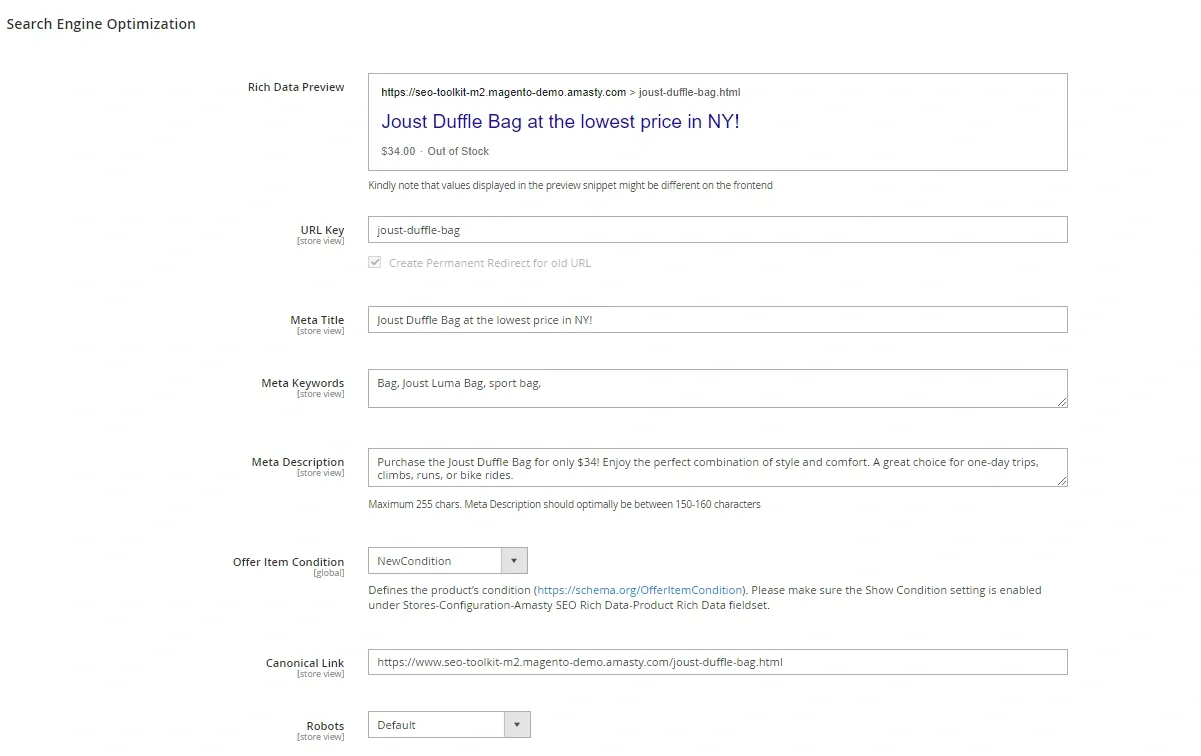
You can also install third-party SEO extensions or work directly with developers to implement custom strategies, including schema markup, advanced filtering, and multilingual SEO setups. This level of flexibility is especially useful for businesses targeting competitive keywords or operating in multiple markets.
Additionally, for marketing, Magento supports rule-based promotions, coupon codes, loyalty programs, and cart price rules. With the right setup, you can run targeted campaigns for different customer segments, track performance, and customize offers with precision.
In contrast, Wix offers a clean and simple SEO setup, perfect for beginners. Its SEO Wiz tool guides you through basic optimization tasks like setting meta tags, creating sitemaps, and improving on-page content. It also allows you to edit URLs, write alt text for images, and connect your store with Google Search Console and Google Analytics.
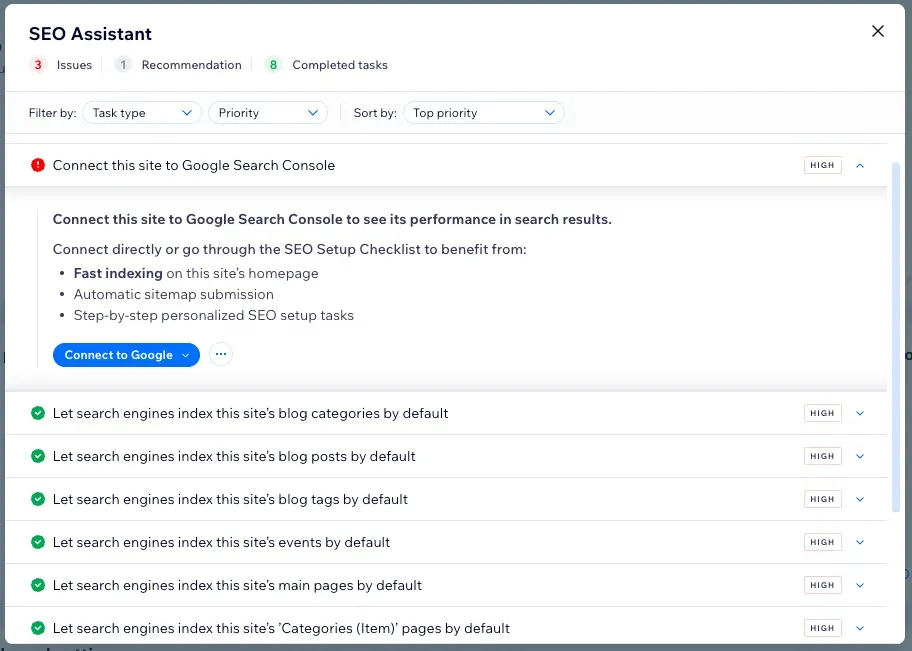
Wix includes built-in tools for email marketing, social media sharing, blogging, and discount campaigns. The platform also provides marketing automation features like abandoned cart recovery and welcome emails, which are easy to activate and customize.
However, Wix has some limitations, especially in terms of deep SEO customization. You have less control over URL structures, some code-level SEO settings are restricted, and advanced integrations may not be as seamless as on Magento.
Apps and Integrations
The verdict:
Between Magento vs Wix, Magento leads when it comes to scalability and long-term performance potential. It’s built for businesses that expect to grow and need a platform that can support high traffic volumes, large inventories, and advanced customizations.
In this section, we’ll compare Magento vs Wix in terms of app availability, integration flexibility, and third-party ecosystem support.
Magento has one of the largest extension marketplaces in the eCommerce world. Through the Magento Marketplace and other third-party sources, you can access thousands of modules to connect your store with email marketing platforms, CRMs, ERPs, payment processors, and more. Because the platform is open-source, developers can also build custom integrations that connect to internal tools or tailor workflows to your exact needs.
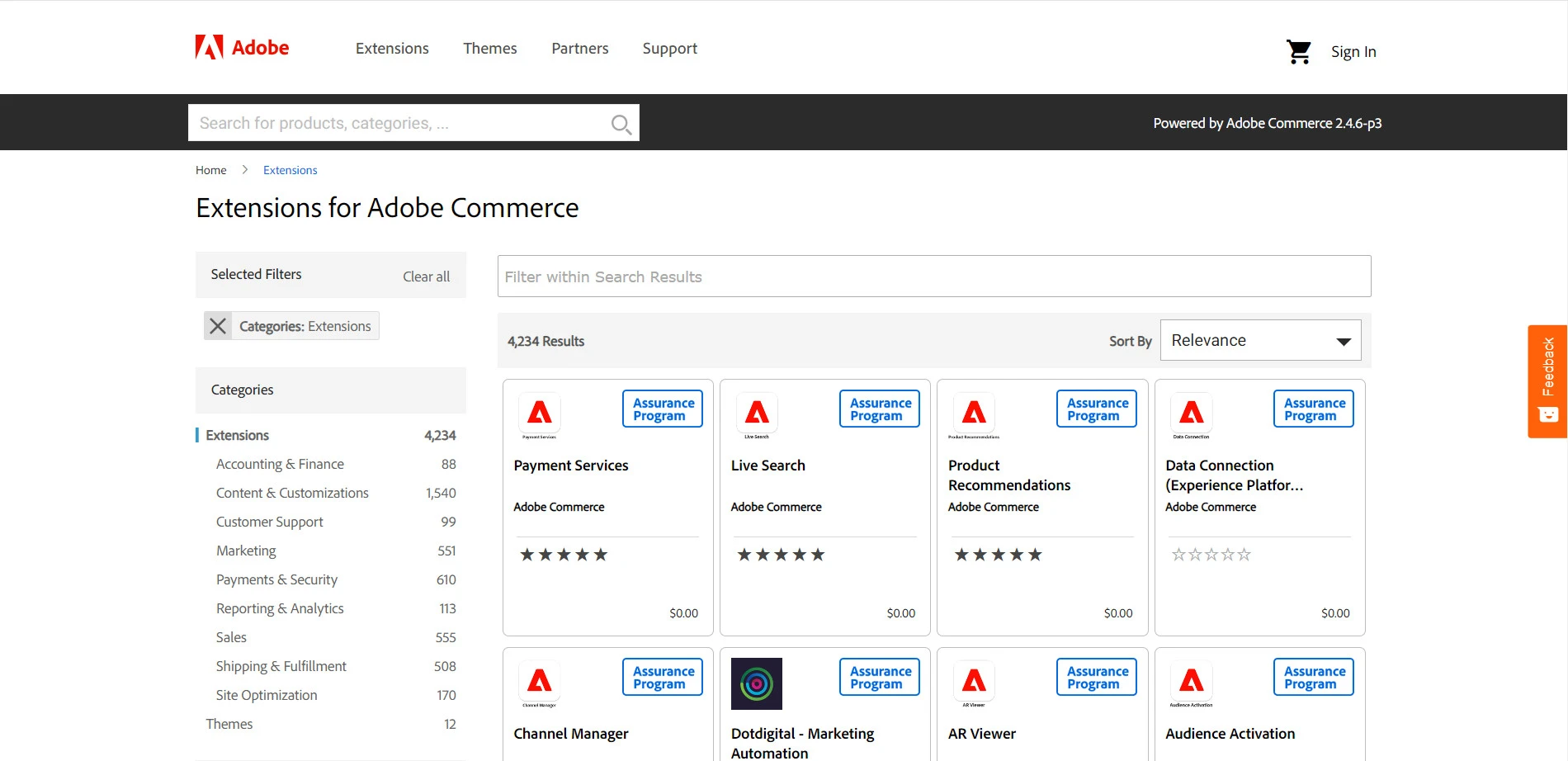
This level of control is especially important for businesses with complex backend systems, multi-channel strategies, or B2B operations. Magento also supports REST and GraphQL APIs, giving you full freedom to develop real-time connections with external platforms.
On the other hand, Wix provides a user-friendly App Market with over 300 apps designed to help store owners add new features quickly. These include tools for email marketing, reviews, live chat, shipping, accounting, and more. Each app is vetted and optimized for the Wix environment, so setup is easy and doesn’t require any coding.

However, Wix is more limited when it comes to custom or advanced integrations. You can use Velo by Wix (a built-in development tool) to create basic custom connections, but you won’t have the same backend access or API control as Magento. This can be a roadblock if your business needs to integrate with systems outside the Wix ecosystem.
Security Compliance
The verdict:
When it comes to security compliance between Magento vs Wix, Wix is the better platform for most users, especially those who want peace of mind without the technical hassle. It offers built-in SSL certificates, PCI DSS compliance, and automatic security updates, all managed behind the scenes. This means you don’t need to worry about patches, server configurations, or external security tools..
In this section, we’ll look at how Magento vs Wix handle security and what responsibilities fall on you as the store owner.
Since Magento is an open-source platform, you are responsible for most aspects of your store’s security. You can choose a secure hosting provider, install security patches, and use third-party security extensions to match your exact risk level and compliance requirements. This is ideal for large businesses, especially in regulated industries or international markets.
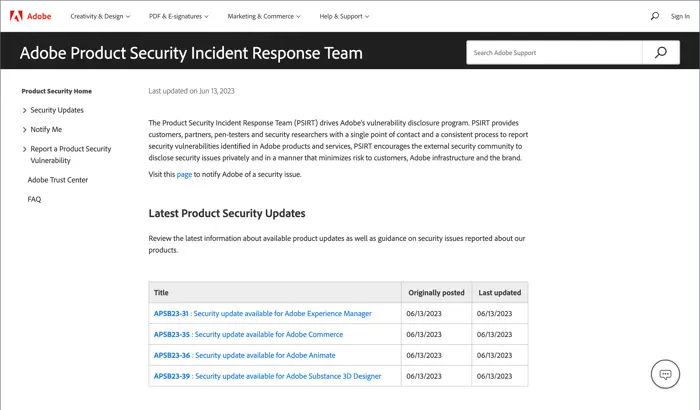
However, this flexibility requires ongoing effort. If you don’t have a technical team or don’t regularly apply updates, your store could be exposed to vulnerabilities. That's why many Magento users work with experienced developers or agencies to keep their store secure and compliant.
In contrast, Wix takes a completely different approach. As a fully hosted platform, it handles all major security tasks for you. This includes automatic SSL certificates, PCI DSS compliance, server monitoring, DDoS protection, and regular software updates.
You don’t need to worry about hosting vulnerabilities, installing patches, or configuring firewalls; Wix takes care of it all in the background. This makes it a great choice for store owners who don’t have the time or technical knowledge to manage security on their own.
Support
The verdict:
Between Magento vs Wix, Wix is the better platform in terms of customer support. It offers a more accessible, structured, and responsive support system with multiple channels available 24/7.
In this section, we’ll compare how Magento vs Wix handle customer support, including the types of help available, the level of responsiveness, and the resources offered to users at different experience levels.
As an open-source solution, Magento does not come with direct support via email or phone call. Instead, users rely on a global developer community, forums, documentation, and third-party agencies for help. There are many helpful resources available, including official user guides and developer docs, but troubleshooting often requires technical knowledge or external assistance. Many store owners using Magento work with a development partner or agency that offers dedicated support and maintenance plans.
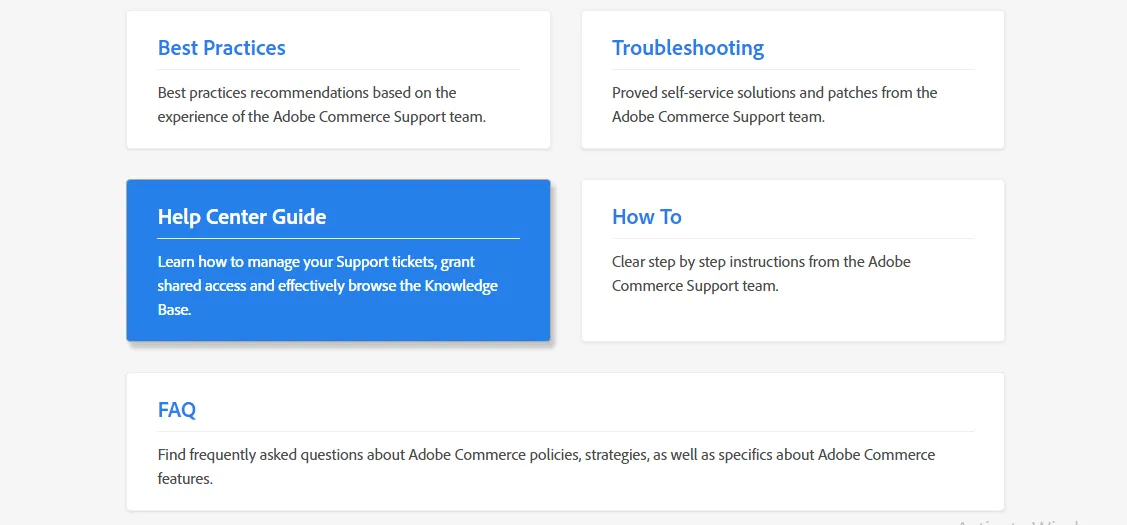
For experienced teams or businesses that prefer to handle issues internally, Magento’s community and flexibility are enough. But for solo entrepreneurs or non-technical users, the lack of direct support can be a challenge.
Meanwhile, Wix takes a very different approach. It offers a fully managed support system that’s ideal for beginners and small business owners. You can access 24/7 customer support through live chat, phone callbacks, or email, depending on your plan. The help center is well-organized and filled with step-by-step tutorials, videos, and FAQs.
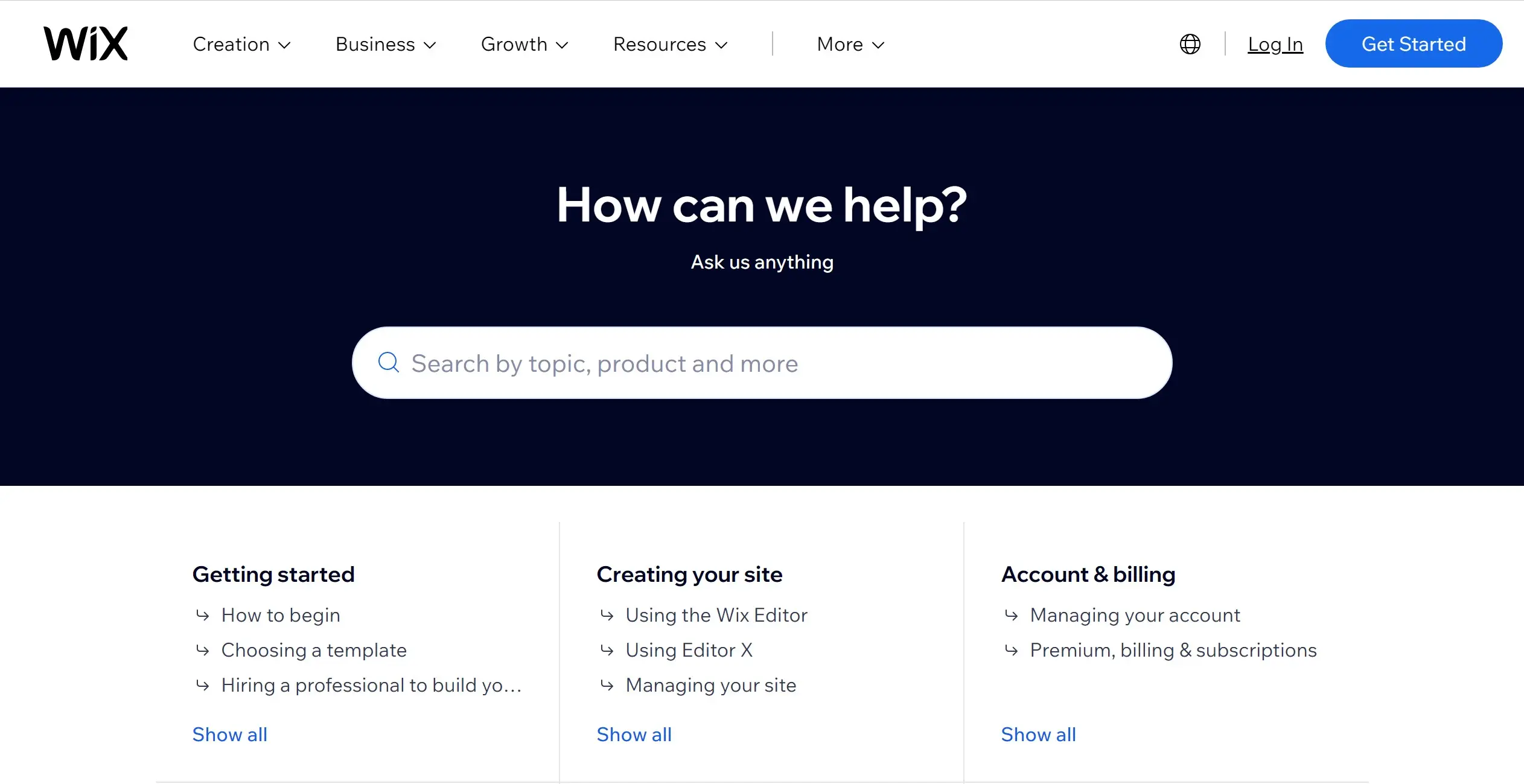
Wix also provides in-editor tips and guided walkthroughs, so you can solve small issues without needing to leave your dashboard. For urgent matters, their response time is generally quick, and their agents are trained to handle common eCommerce questions, from payments and shipping to app integrations.
Pricing
The verdict:
When it comes to pricing between Magento vs Wix, Wix is the more affordable and transparent option. It offers clear monthly plans that include hosting, security, and essential eCommerce features—all in one package. If you are looking for predictable budgeting and lower upfront investment, Wix is certainly the better choice.
Magento is free to download and use, but that doesn’t mean it’s cheap. You’ll need to pay for hosting, SSL certificates, custom development, and ongoing maintenance. Costs can vary widely depending on your store size, traffic, and customization needs.
To help you visualize all the associated fees of Magento pricing, please check out our table below:
Magento Open Source | Commerce Pro | Managed Services | |
Magento license cost | 0 | $22,000–125,000/year | $40,000–190,000/year |
Domain name | $10–400/year | $10–400/year | $10–400/year |
Hosting | From $100/year | From $500/year | 0 |
SSL Certificate | $50–300/year | $5–300/year | $50–300/year |
Theme | $0–10,000 | $0–10,000 | $0–10,000 |
Extensions | $60–600/extension | $60–600/extension | $60–600/extension |
SEO & Marketing | $10,000–40,000/year | $10,000–40,000/year | $10,000–40,000/year |
Payment Integration | 2.9%+ $0.30 | 2.9%+ $0.30 | 2.9%+ $0.30 |
Development | From $1,800 | From $10,000 | From $10,000 |
Maintenance | $50–100/hour | $70–$140+/hour | $70–$140+/hour |
In short, Magento is best suited for businesses that have a budget for development and infrastructure, and that need the flexibility to build complex or high-volume stores. While it offers excellent value for growing brands, the cost and complexity may be too high for smaller operations.
On the other hand, Wix uses a subscription-based pricing model, offering multiple business plans with fixed monthly fees, ranging from $17 to $159 per month. Each plan includes hosting, SSL, security, templates, and eCommerce features, with higher plans unlocking exclusive functions.
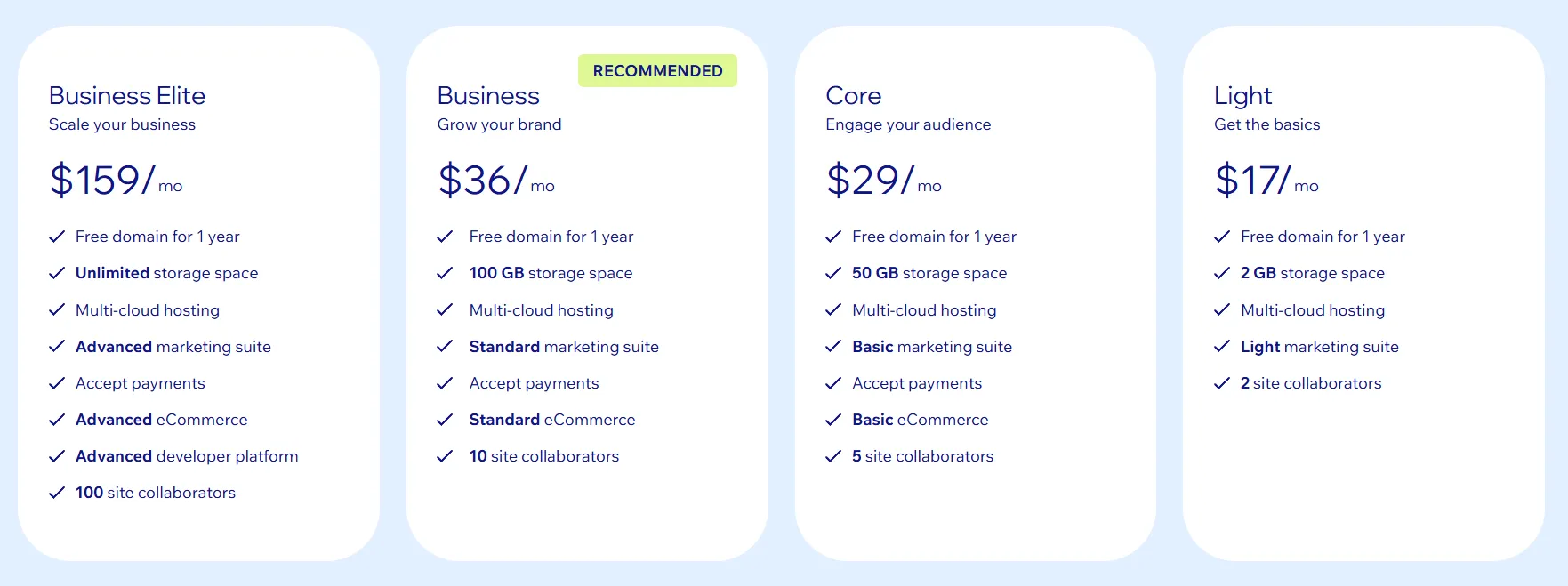
This all-in-one approach makes budgeting easy since you know exactly what you’re paying for each month, and there are no hidden fees for basic functionality. Therefore, Wix is ideal for businesses that want a cost-effective and low-maintenance solution. You don’t need to hire developers or worry about surprise charges. Everything you need to run a professional store is bundled into one simple plan.
Magento vs Wix – Our Methodology
To give you a fair and accurate comparison of Magento vs Wix, we follow a hands-on, research-backed approach. Our goal is to evaluate each platform based on real-world usability, performance, and the needs of different types of eCommerce businesses, from startups to large-scale operations. Here’s how we structure our testing and analysis:
1. Hands-on experience
We’ve used both Magento and Wix to build, customize, and manage online stores. This includes testing core features like product setup, checkout flows, SEO settings, payment gateways, and mobile responsiveness. By working directly within each platform, we understand how intuitive the tools are and what technical skills are required to get things done.
2. Feature-by-feature comparison
Each section of this comparison, pricing, ease of use, flexibility, performance, and more, was evaluated individually. We looked at what’s included out of the box, what requires add-ons or development, and how each platform handles common eCommerce tasks. This helps us determine where one platform clearly outperforms the other.
3. Scalability and growth scenarios
We tested how both platforms hold up under growing demands. For Magento, we explored server control, custom logic, and multi-store support. For Wix, we tested how the platform performs as the catalog size and traffic increase. These tests are based on typical growth patterns of small businesses and mid-market brands.
4. Real user feedback
In addition to our own experience, we analyzed real customer reviews, case studies, and feedback from business owners who’ve built and migrated stores on both platforms. This gave us insights into long-term satisfaction, common complaints, and what types of businesses thrive on each solution.
5. Technical and business context
Because Magento and Wix are built for different users, we tailored our evaluation based on context. For example, we tested Wix from a small business owner's perspective, focusing on speed and simplicity. With Magento, we focused on customization, backend flexibility, and developer workflows.
By combining direct experience with real user feedback and platform research, this Magento vs Wix comparison is designed to help you choose the best solution for your specific needs, not just based on features, but on what actually works in practice.
Magento vs Wix – FAQs
Why is Magento better?
Magento is better for businesses that need full control, advanced customization, and the ability to scale. It supports large product catalogs, complex workflows, and offers powerful B2B features. Since it’s open-source, Magento lets you build a highly tailored store that fits your exact business needs. It’s ideal for growing brands with technical resources or teams who can manage a flexible and customizable system.
Can Wix be used for eCommerce?
Yes, Wix can absolutely be used for eCommerce. It offers a user-friendly drag-and-drop interface, built-in product management, payment gateways, and marketing tools. It’s best suited for small to medium-sized stores that want a simple, all-in-one solution without needing technical skills. Wix is a great choice for new store owners or businesses looking for a quick and affordable way to start selling online.
What is Magento used for?
Magento is used to build robust, scalable, and highly customizable online stores. It’s popular among medium to large businesses that require custom features, advanced product types, multi-store management, or integration with complex backend systems. Magento is especially strong in B2B, international selling, and large inventory setups. It’s often chosen by businesses planning for long-term growth and technical flexibility.
Is Magento or Wix better for eCommerce?
That depends on your business size, goals, and technical resources. Magento is better for businesses that need deep customization, flexibility, and scalability. Wix is better for those who want a fast, easy, and budget-friendly way to launch a store with all the basics included. In short, choose Magento for power and control, and Wix for simplicity and ease of use.
Final Verdict
In conclusion, choosing between Magento vs Wix comes down to one key question: What does your business need: power and flexibility, or simplicity and speed? Both platforms are capable of supporting eCommerce stores, but they serve very different purposes.
Magento is the better choice for businesses that need advanced features, full customization, and room to grow. If you're managing a large product catalog, require B2B functionality, or need custom workflows and integrations, Magento gives you the control to build a tailored, scalable solution. It’s ideal for mid-sized to enterprise businesses with access to development resources.
Wix, on the other hand, is perfect for entrepreneurs and small business owners who want to launch quickly and manage everything easily without technical knowledge. Its all-in-one setup, drag-and-drop editor, and straightforward pricing make it a smart choice for those starting out or running lean operations.
Lastly, if you want to learn more expert tips and insights into eCommerce platforms, please check out other articles on our website.
